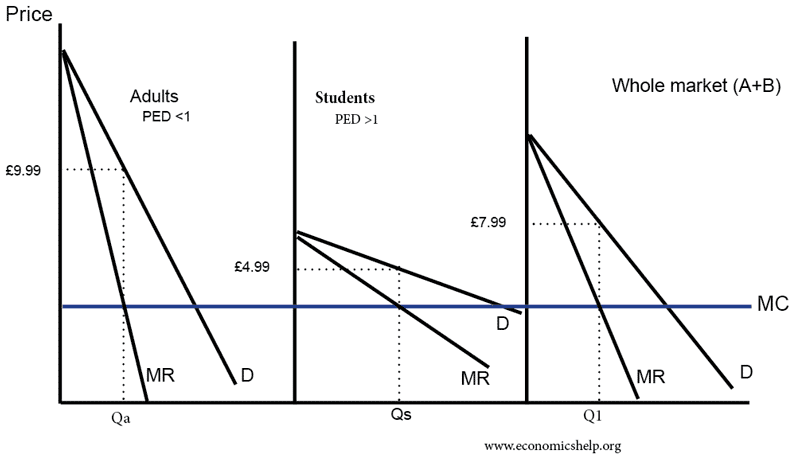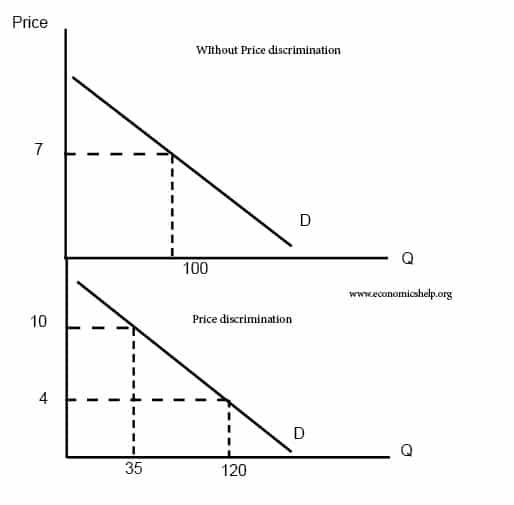Define and Explain Briefly the Different Degrees of Price Discrimination
THE FIRST-DEGREE PRICE DISCRIMINATION. First week only 499.

Third Degree Price Discrimination Economics Help
Price discrimination works when consumers have different preferences and reservation prices.

. First Degree Price Discrimination. Second-degree price discrimination occurs when consumers are charged different prices per unit for different quantities of the same good or service. To the consumers price discrimination results to a decline in con summer prices.
Price discrimination allows firms to increase profits by charging individual customers or groups of customers different prices for the same goods or services. For example a doctor charges different fees for the same operation from rich and poor patients. A textbook example of first-degree price discrimination is eBay.
Prices varying by quantity sold such as bulk purchase discounts. First-degree price discrimination. One of the conditions of perfect first-degree price discrimination is that the firm knows the reservation price of each unit that each of its customers consume.
Second-degree price discrimination means charging a different price for different quantities such as quantity discounts for bulk purchases. Degrees of price discrimination can be applied. For example rail and tube travellers can be subdivided into commuter and casual travellers and.
First second and third-degree. Second-degree price discrimination or. Explain types and methods of measuring elasticity of demand.
Price Discrimination refers to the charging of different prices for the same type of products in different markets. But in second degree discrimination a number of units in one slab or group or block are sold at the lowest price and as the slabs increase the prices charged by the monopolist are lowered. First-degree price discrimination refers to charging each consumer that consumers reservation price but is highly impractical if not impossible.
There will be no consumer surplus. Third Degree Price Discrimination involves charging a different price to different groups of consumers for the same good. Discuss the various uses of elasticity Of demand.
Second-degree price discrimination also called nonlinear price discrimination occurs when a firm charges different prices for different quantities of the product. Refers to a price discrimination in which buyers are divided into different groups and different prices are charged from these groups depending upon what they are willing to pay. The policy of price discrimination can be adopted only when the following conditions are fulfilled.
What are the determinants Of Explain different types Of demand. 12 November 2019 by Tejvan Pettinger. First-degree or perfect price discrimination involves the seller charging a different price for each unit of the good in such a way that the price charged for each unit is equal to the maximum willingness to pay for that unit.
These groups of consumers can be identified by particular characteristics such as age sex location time of use. Other than the cinema business price discrimination is also used in the travel industry. Customers are bidding on product prices and the more they are willing.
The reservation price is the highest price they are willing to pay. Explain the determinants of supply. In the first degree discrimination the monopolist charges a different price for each different unit of the product.
Conditions for price discrimination Conditions for Price Discrimination. We discriminate between things. Charging different prices for each individual unit purchased where people pay their own individual willingness to pay.
The sale of goods abroad at a price which is lower than the selling price of the same goods at the same time and in the same circumstances at home. Depending on the information available and the given circumstances three types ie. Price discrimination refers strictly to the practice by a seller of simultaneously charging different prices to different buyers for the same goods.
In a Nutshell. Different Types of Price Discrimination. Cut-price fuel on Tuesdays and Thursdays is a form of price discrimination.
In the real world third-degree price discrimination is quite common. Third-degree price discrimination means charging a different price to different consumer groups. It can have at least three different forms which are called degrees of price discrimination.
Prices varying by time of purchase such as peak-time prices. By charging different prices firms get more profit than charging single prices. 14 December 2019.
Personal price discrimination refers to the charging of different prices from different customers for the same product. Second Degree Price Discrimination. Railways and airlines practice this type of price discrimination.
The seller may charge different prices to each buyer and for each unit. In the first degree you allow customers to pay for the product as much as they want. Solution for Briefly explain price discrimination.
Define elasticity of demand. Price discrimination is of following three types. Also it results to an increase in the prices of the same product which could be obtained at a lower price if it was bought in a different market segment Liu Tong 2009 p72.
It is a microeconomic pricing strategy where the pricing mechanism depends upon the monopoly of the company preferences of the customers uniqueness of the product and the willingness of the people to pay differently. This is also known as perfect price discrimination or personalized pricing. In its most literal sense discrimination is the act of making a distinction between one thing and other.
Explain the types and methods of measuring elasticity of demand. Charging the maximum price a customer is willing to pay 1st degree discrimination Charging different prices according to the quality of the product or services consumed 2nd degree discrimination Charging different prices for similar goods premium pricing. This involves charging consumers the maximum price that they are willing to pay.
Weve got the study and writing resources you need for. What are the main types of price discrimination. Start your trial now.
There are several types of price discrimination. Dumping is an international price discrimination in which an exporter firm sells a portion of its output in a foreign market at a very low price and the remaining output at a high price in the home market Haberler defines dumping as.

Price Discrimination Economics Help

Price Discrimination Conditions For Price Discrimination With Examples

0 Response to "Define and Explain Briefly the Different Degrees of Price Discrimination"
Post a Comment